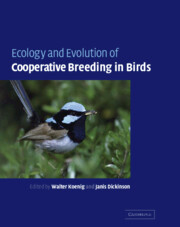Book contents
- Frontmatter
- Contents
- List of contributors
- Introduction
- 1 Evolutionary origins
- 2 Delayed dispersal
- 3 Fitness consequences of helping
- 4 Parental care, load-lightening, and costs
- 5 Mating systems and sexual conflict
- 6 Sex-ratio manipulation
- 7 Physiological ecology
- 8 Endocrinology
- 9 Incest and incest avoidance
- 10 Reproductive skew
- 11 Joint laying systems
- 12 Conservation biology
- 13 Mammals: comparisons and contrasts
- 14 Summary
- Names of bird and mammal species mentioned in the text
- References
- Taxonomic index
- Subject index
2 - Delayed dispersal
Published online by Cambridge University Press: 02 December 2009
- Frontmatter
- Contents
- List of contributors
- Introduction
- 1 Evolutionary origins
- 2 Delayed dispersal
- 3 Fitness consequences of helping
- 4 Parental care, load-lightening, and costs
- 5 Mating systems and sexual conflict
- 6 Sex-ratio manipulation
- 7 Physiological ecology
- 8 Endocrinology
- 9 Incest and incest avoidance
- 10 Reproductive skew
- 11 Joint laying systems
- 12 Conservation biology
- 13 Mammals: comparisons and contrasts
- 14 Summary
- Names of bird and mammal species mentioned in the text
- References
- Taxonomic index
- Subject index
Summary
Cooperatively breeding birds are species in which social groups comprise at least three individuals that share parental care at a single nest. Although same-sex group members are sometimes non-relatives (Davies 1992, the majority of cooperative breeders exhibit delayed dispersal of offspring, which subsequently forgo reproduction and become non-reproductive helpers at the nests of parents or other close relatives. Group formation, social interactions, and reproduction within groups are characterized by both cooperation and competition among family members (Mumme 1997). In many cases, helpers derive indirect fitness benefits by increasing the productivity of their parents' nest. However, because helping at the nest only partially compensates helpers for failing to breed independently, helpers usually pay a net fitness cost by helping instead of breeding on their own (Stacey and Koenig 1990a).
Because most helping appears to represent a “best of a bad job” strategy, rather than an adaptive peak, it has become clear that we can understand the evolution of kin-based helping only by investigating why offspring forgo personal reproduction in the first place, and the associated question of why offspring, once they postpone personal reproduction, remain on their natal territories (Emlen 1982a). The decision to delay dispersal should be the key to the formation of family units, hence the aim of this chapter is to explore the selective basis of delayed dispersal. The selective factors favoring postponement of reproduction and helping are discussed in Chapter 3.
The route leading to cooperative breeding in multigenerational family groups involves a series of decisions.
- Type
- Chapter
- Information
- Ecology and Evolution of Cooperative Breeding in Birds , pp. 35 - 47Publisher: Cambridge University PressPrint publication year: 2004
- 90
- Cited by

